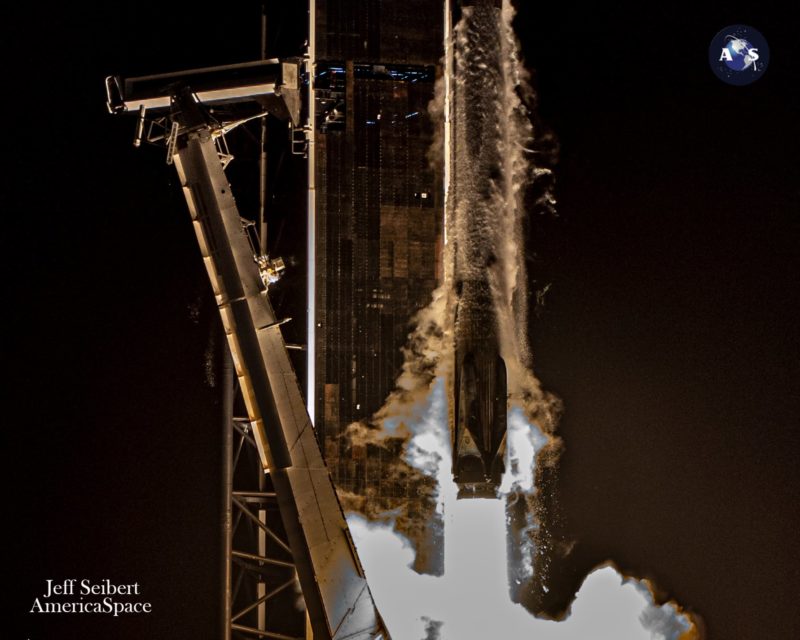
After almost two flightless months, a veteran Falcon 9 booster which has already launched eight humans and a powerful geostationary communications satellite roared into the night at 3:14 a.m. EDT Sunday. Liftoff of the B1061 core—the ninth Falcon 9 to log as many as four flights—occurred from historic Pad 39A at the Kennedy Space Center (KSC) in Florida, carrying SpaceX’s CRS-23 Dragon cargo mission to the International Space Station (ISS). Originally scheduled to fly early Saturday morning, the launch was scrubbed due to unacceptable weather.
About 12 minutes after leaving the Space Coast, the Dragon separated from the second stage of the booster and is now on course for a rendezvous and autonomous docking at the station tomorrow. This morning’s launch also marked the first use of SpaceX’s newest Autonomous Spaceport Drone Ship (ASDS), “A Shortfall of Gravitas” (ASoG).
First used last 15 November to lift Dragon Resilience and Crew-1 astronauts Mike Hopkins, Victor Glover, Shannon Walker and Soichi Noguchi to the ISS, the B1061 core chalked up a second human-carrying mission on 23 April when she boosted Dragon Endeavour and the Crew-2 team of Shane Kimbrough, Megan McArthur, Aki Hoshide and Thomas Pesquet into orbit.
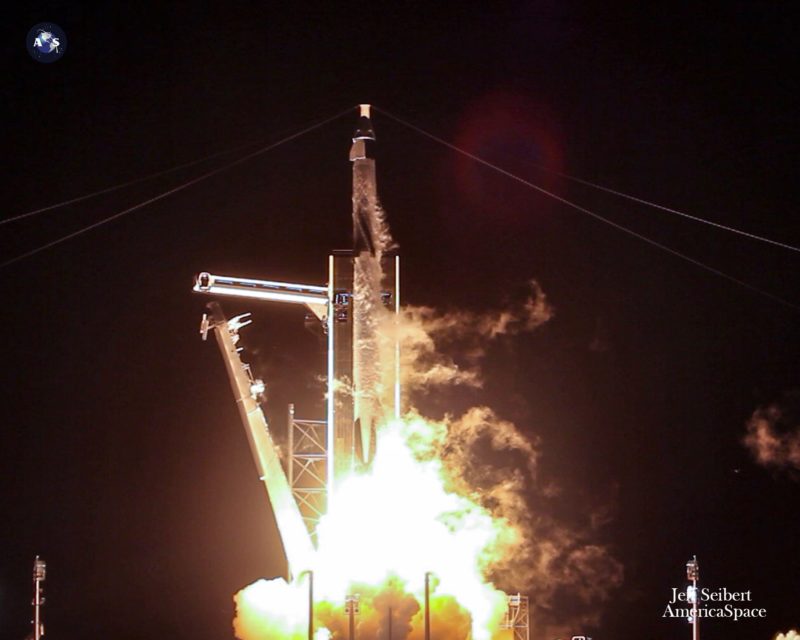
More recently, the booster lofted SiriusXM’s powerful SXM-8 broadcasting satellite on the first leg of its trek to geostationary orbit on 6 June. After several weeks of on-orbit tests, SXM-8 was declared fully functional last month by prime contractor Maxar and has now been handed over to SiriusXM for routine operations.
Today’s flight was the 21st Falcon 9 mission in the first eight months of the year, equaling SpaceX’s achievement from the entirety of 2018, but falling shy of its “personal best” of 26 launches, set last December.
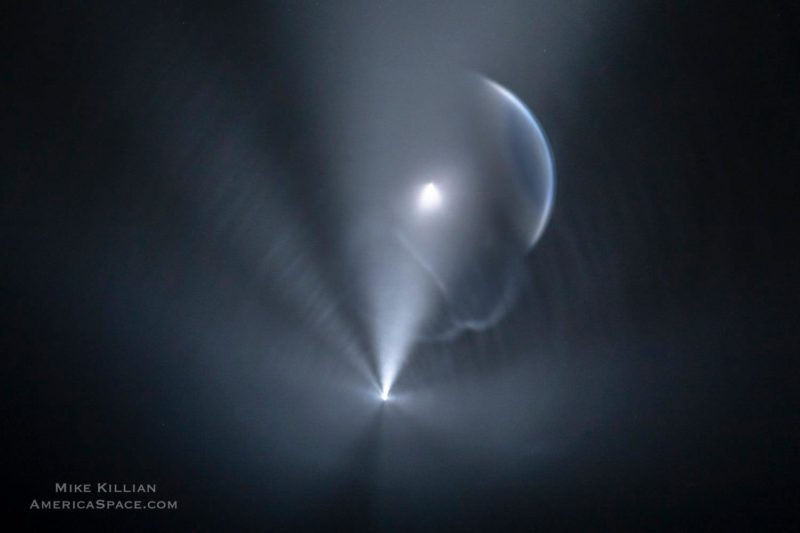
That said, the Hawthorne, Calif.-headquartered organization had staged only 14 missions by this time last year, which—despite a two-month hiatus since its most recent launch on 30 June—still puts 2021 in pole position to secure a new record when the midnight bell tolls on New Year’s Eve.
And 2021 has also proven an exceptional year for Falcon 9 reusability, with 21 missions executed by only nine boosters, one of which flew five times between January and June. Notwithstanding the loss of a booster in February, the others have returned safely to alight 19 times on the ASDS and once on solid ground at Landing Zone (LZ)-1 at the Cape. Other records included the shortest interval (a mere 27 days) between flights by the same booster and the first Falcon 9s to record eighth, ninth and tenth missions.
Not to be outdone, the Cargo Dragon spacecraft launched this morning was itself embarking on its second orbital voyage, having previously supported the CRS-21 mission, which launched last December and returned to a smooth splashdown off the Florida coastline, to the west of Tampa, in mid-January.
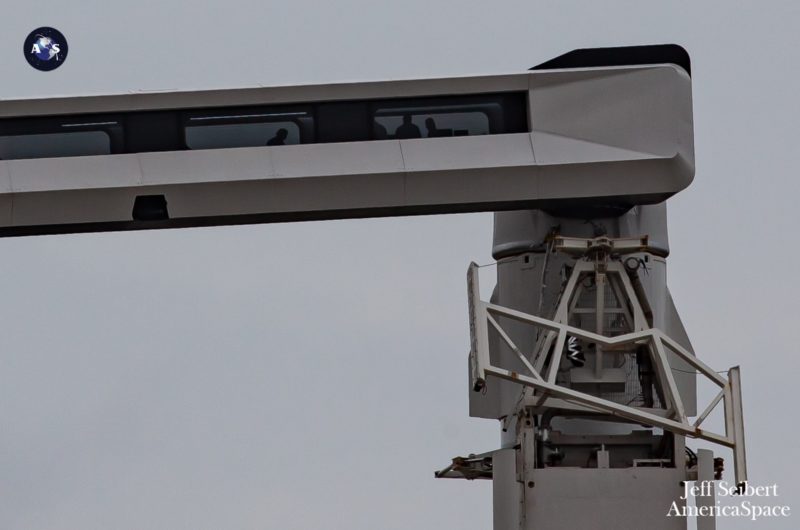
Although three of SpaceX’s old-style Cargo Dragons were used as many as three times under the first-round Commercial Resupply Services (CRS1) contract—most recently in March 2020—the newer CRS2 craft is touted as being able to fly up to five missions. It also has the capacity to dock autonomously at the ISS, rather than being captured and “berthed” by means of the station’s robotic assets. This correspondingly imposes fewer demands upon crew time and labor.
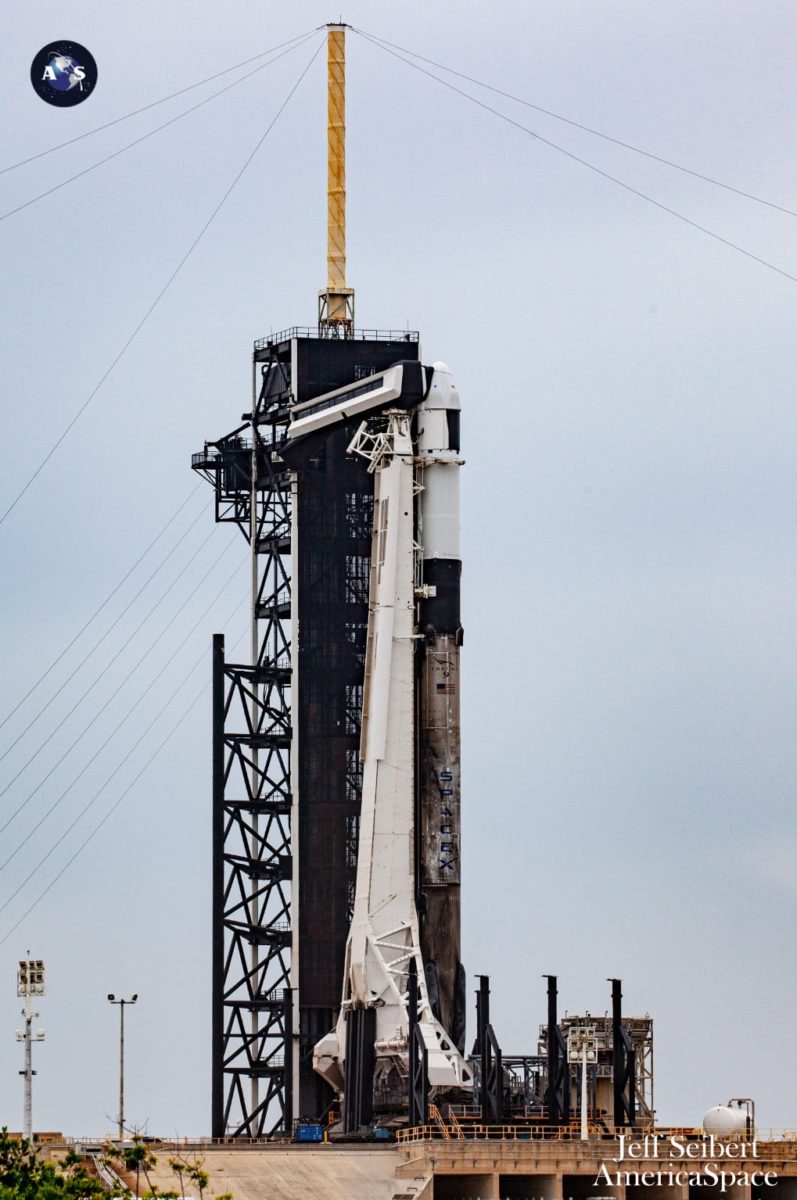
“Duties for the crew on approach are significantly different with this version of Dragon,” NASA previously told AmericaSpace. “Crew has no active tasks like they did for capture and are strictly monitoring. They still have full capability to send commands to vehicle for things like abort, but if all goes well they don’t have to send any commands or take any actions for Dragon to dock.”
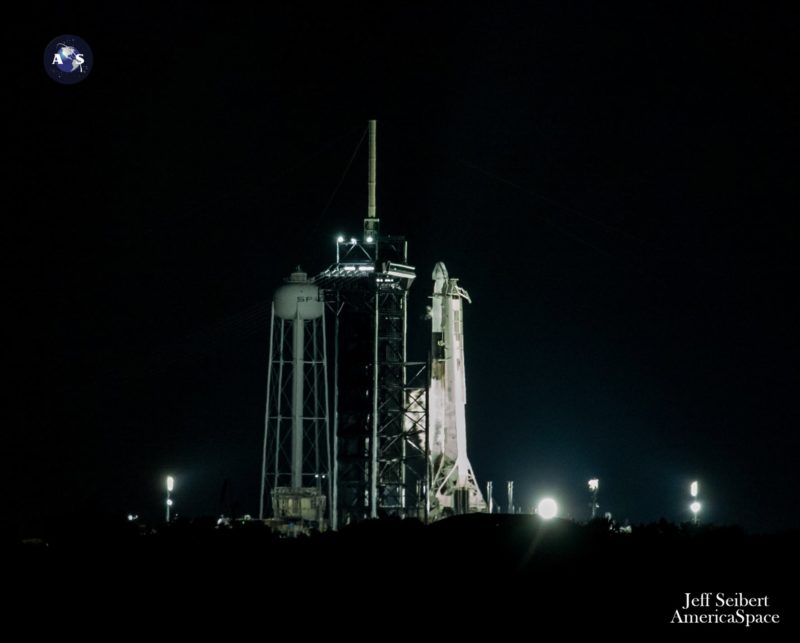
In the meantime, last Tuesday the Cargo Dragon was transported from its processing facility to the Horizontal Integration Facility (HIF) near Pad 39A to be mounted atop the Falcon 9. The complete stack—which measures 230 feet (70 meters) from top to tail—was rolled horizontally out to the pad early Wednesday morning and raised vertical. And later that same evening, B1061’s nine Merlin 1D+ first-stage engines roared to life for a few seconds in a customary Static Fire Test.
The weather outlook for Saturday’s early-hours liftoff was initially predicted to be about 50-50, although by Friday the 45th Weather Squadron at Patrick Space Force Base downgraded its projection to only 40-percent favorable.
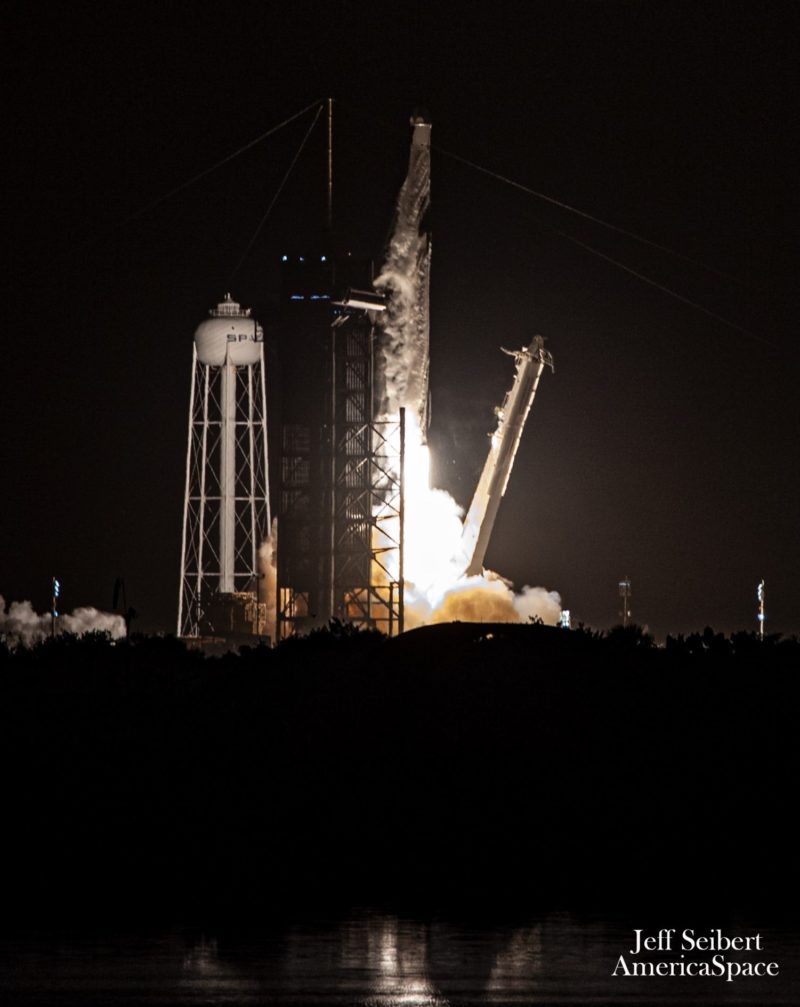
Scattered coastal showers and isolated thunderstorms, combined with “plentiful mid- and upper-level moisture over the Florida peninsula”, courtesy of Tropical Storm Ida, were expected to create potential violations of the Cumulus Cloud Rule, the Flight Through Precipitation Rule and the Thick Cloud Layers Rule. Conditions were expected to improve to 60-percent favorable in the event of a launch delay to Sunday morning, rising to 80 percent for the next available attempt on Tuesday, 31 August.
Unsurprisingly, in view of the grim outlook, Saturday’s launch attempt was scrubbed shortly before 3:30 a.m. EDT and teams began to reconfigure for a second try at 3:14 a.m. EDT Sunday.
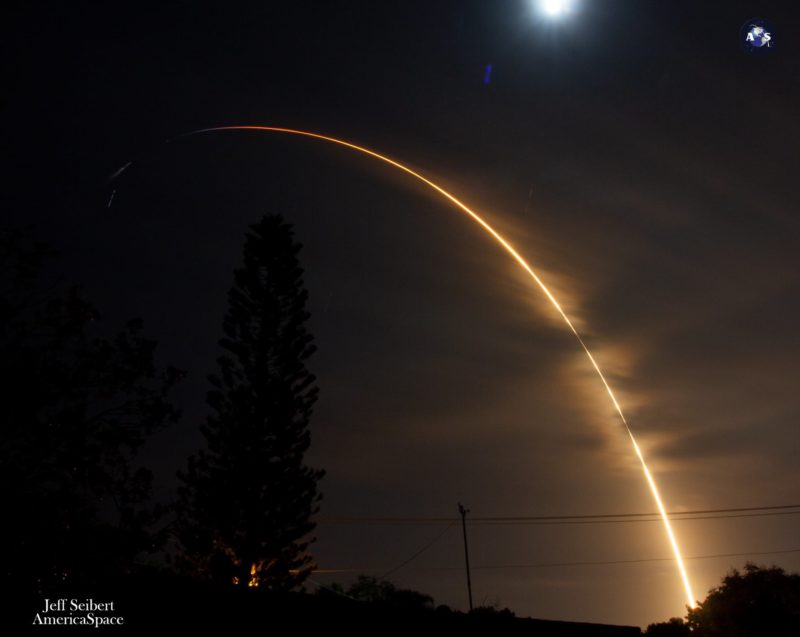
With a markedly improved weather picture, Sunday’s launch was charmed. B1061 behaved admirably on her fourth flight, the nine Merlins burning furiously with a combined thrust of 1.7 million pounds (770,000 kg) for the first 2.5 minutes of flight. The core then separated from the stack and completed a smooth series of three Entry and Landing Burns to alight on the deck of SpaceX’s newest ASDS, “A Shortfall of Gravitas” (ASoG), situated about 190 miles (300 km) offshore in the Atlantic Ocean.
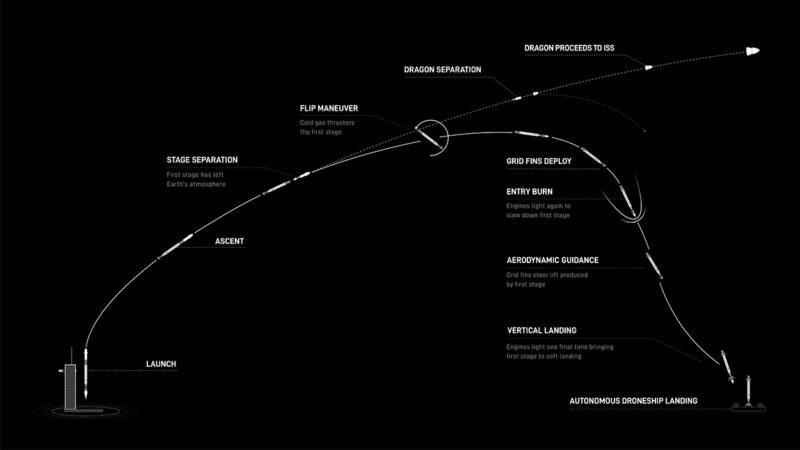
SpaceX’s two other in-service drone ships—“Of Course I Still Love You” (OCISLY) and “Just Read the Instructions” (JRTI)—have successfully recovered 66 returning Falcon 9 cores between April 2016 and last June. Added to that list, 23 returning cores alighted on solid ground at either Cape Canaveral Space Force Station, Fla., or Vandenberg Space Force Base, Calif., between December 2015 and June 2021. As a result, including today’s ASoG landing, SpaceX has now safely landed booster cores on 90 occasions.
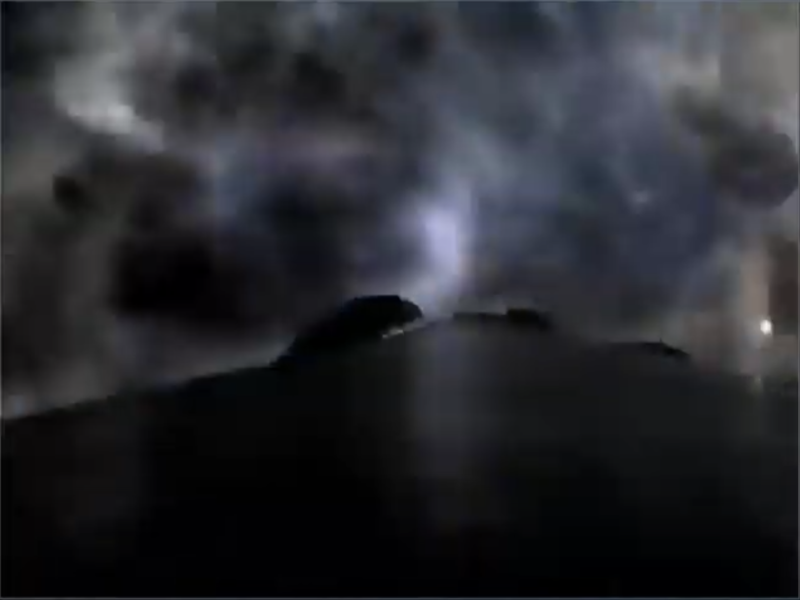
With OCISLY having been transferred to Vandenberg Space Force Base, Calif., earlier this summer, JRTI and ASoG are expected to support a full plate of East Coast booster recoveries in the coming months. ASoG completed sea-trials last month, before arriving at Port Canaveral in mid-July. It was towed out to the CRS-23 recovery location by the tug Finn Falgout overnight on Thursday/Friday.
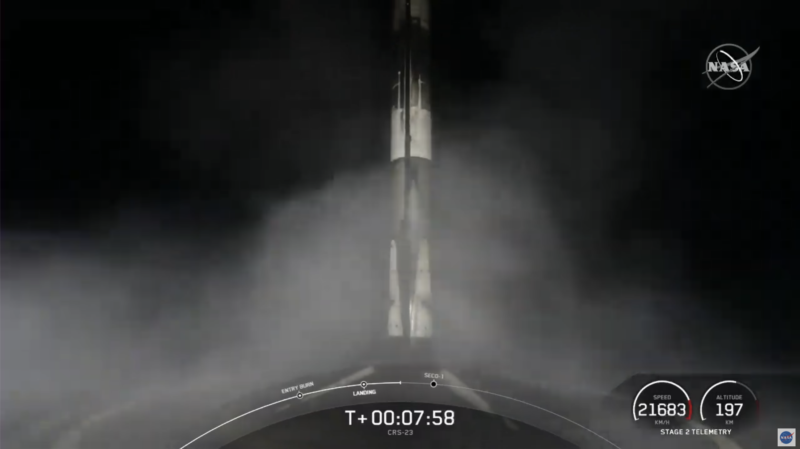
Following the departure of B1061, the Falcon 9’s second stage continued the push towards low-Earth orbit, powered by its single Merlin 1D+ Vacuum engine. This positioned the CRS-23 spacecraft for separation into free flight about 12 minutes after launch. It is currently in transit to the ISS, with an autonomous rendezvous and docking at the forward-facing port of the station’s Harmony node targeted for 11 a.m. EDT Monday.
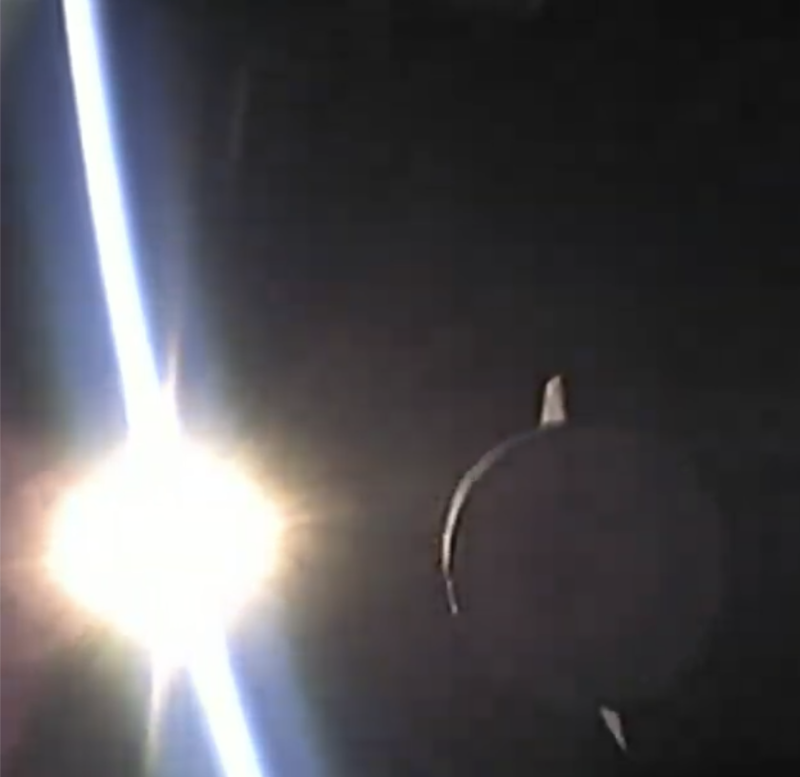
Aboard the Cargo Dragon are 4,315 pounds (1,957 kg) of payloads, equipment and supplies for the incumbent Expedition 65 crew of Commander Aki Hoshide of Japan, Russian cosmonauts Oleg Novitsky and Pyotr Dubrov, U.S. astronauts Mark Vande Hei, Shane Kimbrough and Megan McArthur and France’s Thomas Pesquet. This includes 1,058 pounds (480 kg) of crew supplies, 2,305 pounds (1,046 kg) of science investigations, 153 pounds (69 kg) of Extravehicular Activity (EVA) equipment, 746 pounds (338 kg) of vehicle hardware and 53 pounds (24 kg) of hardware for the Russian Operational Segment (ROS).
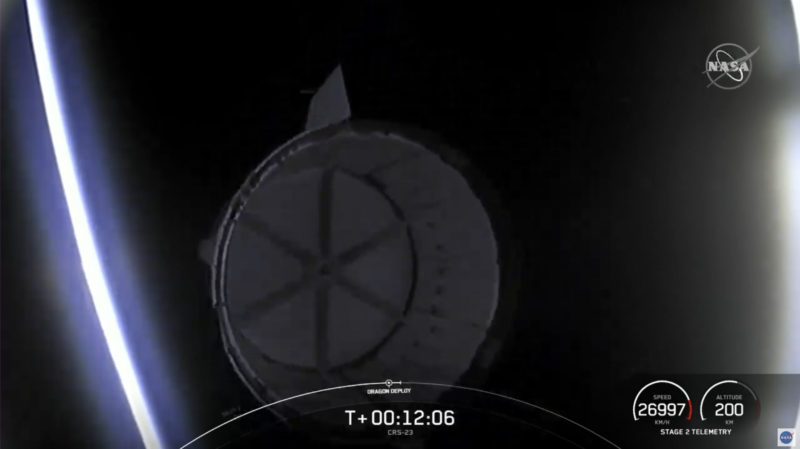
Over the course of the last week, Kimbrough and McArthur completed requisite On-Board Training (OBT) and rendezvous preparations in advance of CRS-23’s arrival. On Friday, all five U.S. Operational Segment (USOS) crew members participated in a cargo review and conference with ground controllers.
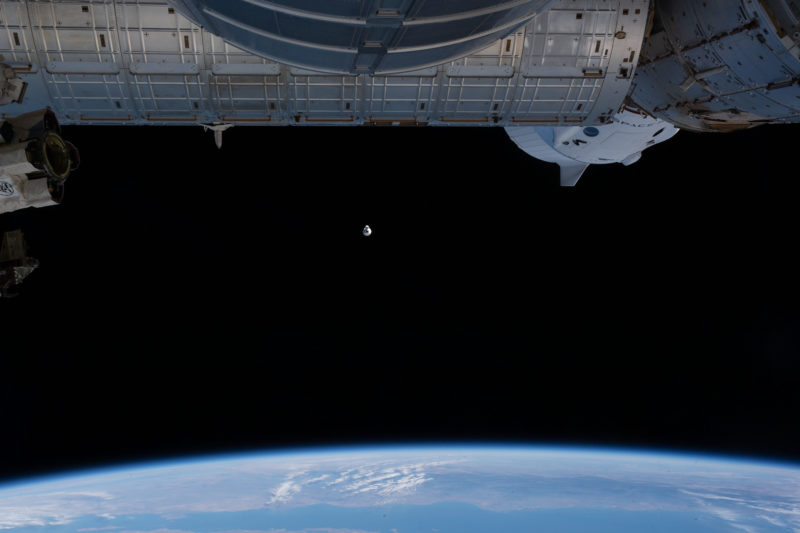
The science heading uphill includes the Italian-led Reducing Arthritis Dependent Inflammation First Phase (READI FP), which seeks to understand the effects of microgravity and space radiation on the growth of bone tissue. It will investigate whether bioactive metabolites—in this case, vegetal extracts generated as waste products from wine production—can better protect human bones during spaceflight.
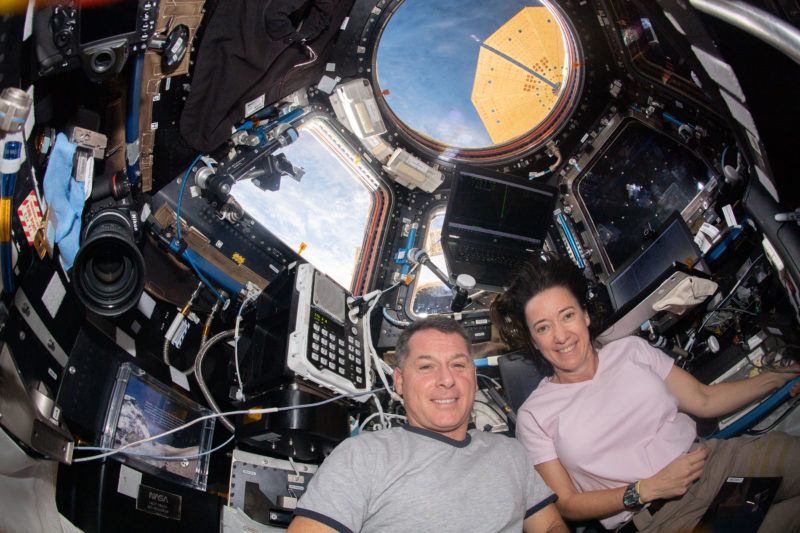
German researchers are providing the Retinal Diagnostics study to capture images of astronauts’ eyes in order to document the well-known phenomenon of Space-Associated Neuro-Ocular Syndrome (SANS). This vision problem affects over two-thirds of astronauts and is thought to be associated with missions longer than a month in duration.
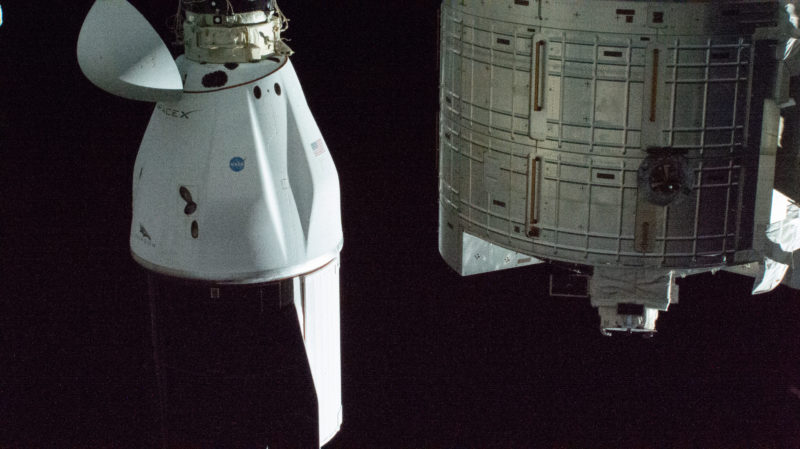
NanoRacks, Inc., and Tokyo-based tech startup GITAI, Inc., have supplied an experimental robot arm which will be operated inside the commercial Bishop airlock, which arrived at the ISS last December. Results from these trials could support the development of future robotic workers to support station crews and tasks, as well as servicing, assembly and manufacturing tasks in low-Earth orbit.
Elsewhere aboard CRS-23 are a group of materials—including concrete, fiberglass composites, thin-film solar cells, micro-optical chips and 3D printed polymers—to assess their performance and a batch of thale cress for ongoing plant studies in the station’s Veggie facility.
Finally, the Faraday Research Facility will be installed in a pair of EXpedite the PRocessing of Experiments for Space Station (EXPRESS) racks and will support tests of an implantable, remote-controlled drug-transfer system which might prove a future game-changer for long-term management of chronic conditions on Earth.




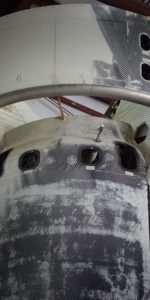

Outstanding.
hi